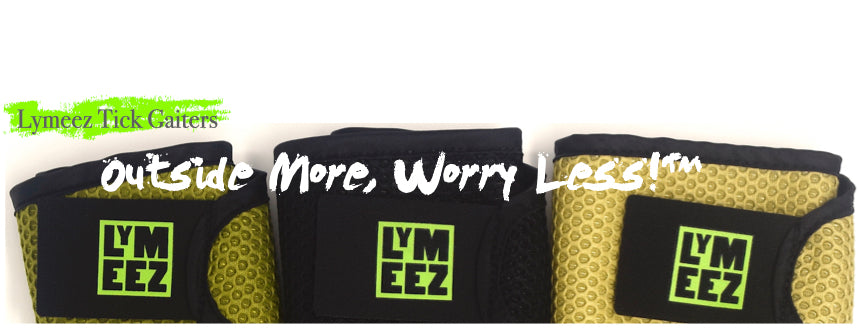About Lymeez
Living in New Hampshire became annoying and even perilous in the early 2000’s as the population of diseased ticks surged. You couldn’t step off the porch without soon finding a questing tick climbing up your leg—if you were lucky enough to see it. The photo is from our former house in NH.

Isn’t New Hampshire beautiful?
The main culprit in spreading Lyme disease (and anaplasmosis, babesiosis, ehrlichiosis and other pathogens) is the black legged deer tick. Many other tick species are also carrying pathogens, but the bulk of infections come from this particular tiny parasite.

Deer ticks come with the territory!
I got Lyme disease, but with no long-term damage because of quick treatment and a month of antibiotics. Incidentally, I used to spend 30 minutes a day picking ticks (mostly engorged because otherwise I couldn’t find them) off of my dog, Clara. She, too, had Lyme disease.

You gotta love that big spot on Clara’s tongue!
We decided to see if we could find a solution to preventing tick bites. We knew that ticks didn't fly or jump. Nearly all ticks climb onto humans at the feet and lower legs from the ground, leaf litter and brush. We also knew that ticks had an instinct to climb, which is why they’re often found around the head and neck. (Remember, they don’t fall from trees.)
We began in 2012 with our first product. The basic design principle—repelling ticks from where they start their climb—was part of an overall practical strategy. Any tick prevention strategy is only effective if it is used—it is difficult to always dress in special treated clothing, but easy to throw on gaiters.
We wanted a look and feel that was more functional and didn’t look like nerdy pulled up socks. Amazing to us, it took quite a while to find a mill with a knitting machine that could produce the open mesh holes which we thought gave it the right look and function. The open mesh also turned out to be terrific in fitting the leg.

We finally created the open mesh gaiters we had envisioned!
Microencapsulated Permethrin
All of Lymeez products are treated with microencapsulated permethrin capsules. Millions of microcapsules of permethrin are infused into each fiber of Lymeez Tick Gaiters. If you think about it, this is pretty high tech stuff—putting liquid permethrin inside of really tiny capsules. It's only been doable in production for about a decade.
Serendipity!
But there was an extraordinary serendipitous event associated with the open knit stretch pull on product.
Remember, now that we’re making tick-repelling products, we’re deep into tick behavior and they are everywhere around our house in New Hampshire. One day we put a tick onto our leg while wearing a knit gaiter in order to see what the tick would do.
The tick began to explore the holes which slows them down and causes them to be exposed to more repellent.
Wow! we thought, they like the mesh! We wondered if there is a type of mesh that confounds ticks even more than the simple open mesh.
It took us another two years scouring world suppliers for the right mesh. We found it in what is called 3D spacer mesh. It is used in many applications, sneakers, motorcycle seats, etc. The knitting technology is fairly new, invented in Germany. It is actually three layers (two horizontal and one vertical) of knitting. We think it is a very, very cool technology.
But not just any 3D mesh would do. It has to light enough to breathe and wrap around the leg. The pores and ribs and depth of the mesh need to right-sized for the ticks. It also needs to affordable.
But after more experiments with an awful lot of different meshes we hit on what seemed to the right mesh. Sure enough, it worked! And it's now patented.
Another Accidental Discovery
Another fortuitous event occurred as we were searching for the right 3D mesh. We had tables piled high with 3D mesh from many, many suppliers. We also had some velcro hook around. We noticed that the velcro hook was sticking to some of the 3D mesh. Eureka! We knew we had to figure out how to close the wrap around the calf. The solutions we faced were not elegant. The calf is a tricky shape. There is great variation in calf sizes. The obvious solution, used by most calf wraps (compression socks, braces, etc.) are fields and straps of hook and loop velcro. But for us, this approach would dramatically cut down the slow-down effect of the 3D mesh—it would be obscured by all the hook and loop. So when we realized that the 3D mesh would act as the “loop” in the hook and loop we were doubly happy with the approach.

Man vs. Tick. Tick confounded. Man wins.
Measuring the Effectiveness of the 3D Mesh
We wanted to quantify the slow-down effect of the mesh. So we got some laboratory (disease-free) from a laboratory. (By the way, wrangling hundreds of deer ticks is no fun at all!)
We measured the speed of ticks traversing a plain pant leg versus a leg with an untreated pair of Lymeez. (In other words, there was no permethrin involved in the speed testing.)
We were very, very pleased when the study showed that the 3D mesh gaiter slowed down the ticks by between 4 and 8 times (vs plain pants tucked into socks)! Some of our customers enjoy watching the ticks become confounded. One of the calls is “Lymeez-land.”
Below is a simple chart of the results. The complete analysis can be found here.

I should note that the statistical analysis was performed not by us, but by a Professor of Statistics from the University of New Hampshire.
Note also that although we haven’t measured the slow-down effect of the knit mesh product—one of those things we just don’t seem to get around to doing—we have observed a similar slow-down effect on the stretch mesh.


